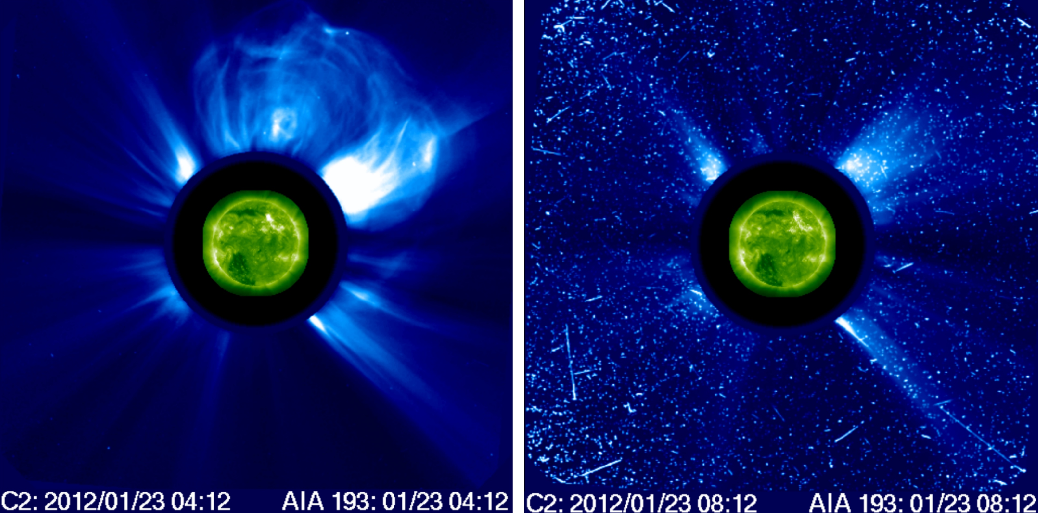Astronomy Object of the Month: The rotation of Comet NEOWISE
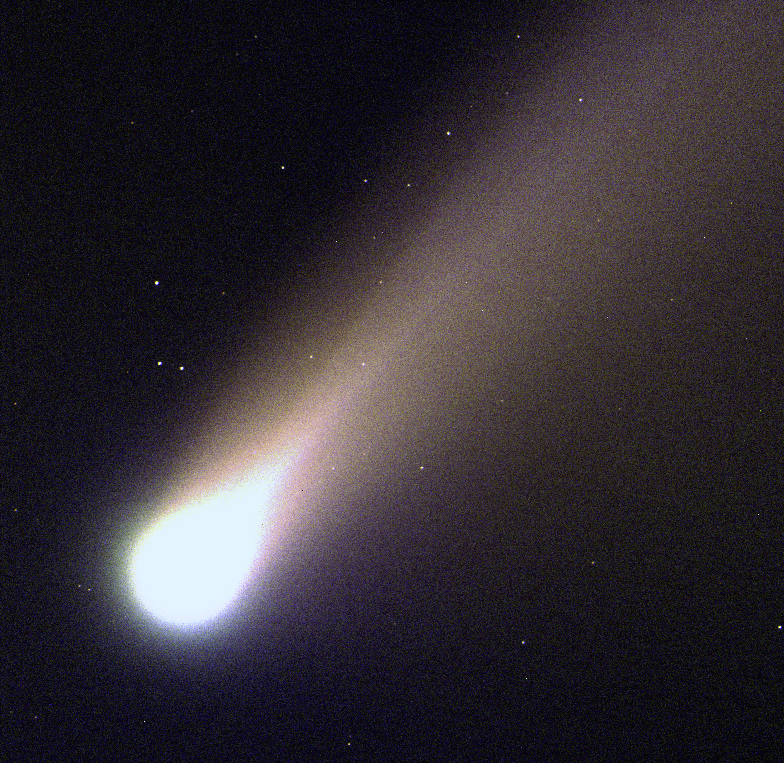 Comet C/2020 F3 (NEOWISE) embellished the 2020 summer sky. It left many memories and beautiful photos, but, most of all, valuable scientific data. The international Gemini Observatory in Hawaii was used to observe the comet by the team led by Michał Drahus from the JU Astronomical Observatory in Krakow. The obtained observational data allowed for a detailed study of the material evaporated from the comet as it traveled through the inner regions of the Solar System.
Comet C/2020 F3 (NEOWISE) embellished the 2020 summer sky. It left many memories and beautiful photos, but, most of all, valuable scientific data. The international Gemini Observatory in Hawaii was used to observe the comet by the team led by Michał Drahus from the JU Astronomical Observatory in Krakow. The obtained observational data allowed for a detailed study of the material evaporated from the comet as it traveled through the inner regions of the Solar System.
Original paper: Drahus, M., Guzik, P., Stephens, A., Howell, .S.B., Zoła, S., Sabat, M., Reichart, D.E., Rotation of Comet C/2020 F3 (NEOWISE), The Astronomer's Telegram (2020).
The Great Conjunction of Jupiter and Saturn as the Christmas Star
Registration for the Astrolabium Competition starts
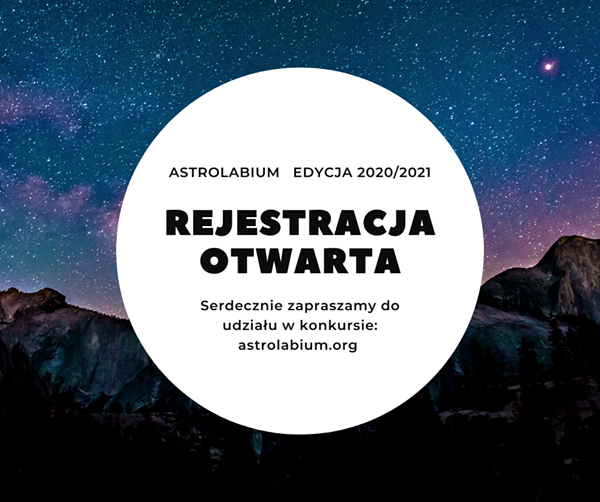 Registration of participants for the 4th edition of the National Astronomical Competition Astrolabium is now open and will last until the end of March 2021. It is also the deadline for paying the competition fees. We cordially invite you to read the Competition Regulations and visit our www or Facebook.
Registration of participants for the 4th edition of the National Astronomical Competition Astrolabium is now open and will last until the end of March 2021. It is also the deadline for paying the competition fees. We cordially invite you to read the Competition Regulations and visit our www or Facebook.
We will post the first competition experiences soon!
Our Observatory on air
 Starting from December 2020, employees and associates of our Observatory talk about the most interesting astronomical objects in Radio Kraków - every Tuesday, at 11:35. We invite you to listen the broadcast!
Starting from December 2020, employees and associates of our Observatory talk about the most interesting astronomical objects in Radio Kraków - every Tuesday, at 11:35. We invite you to listen the broadcast!
Dr. Stanisław Zięba, one of the initiators and coordinators of many years of radio observation of the Sun at the Astronomical Observatory of the JU (1940-2020)
 Dr. Stanisław Zięba was born on July 12, 1940 in Marcyporęba. He graduated in astronomy and physics at the Jagiellonian University in 1962 and 1963, defending his master's theses in both these disciplines. After joining the Astronomical Observatory, he studied the solar radiation and solar activity cycles. He actively participated in the team preparing systematic observations of solar radiation, with the use of new equipment on 810 MHz wave. His doctoral dissertation (1971), written under the supervision of prof. Karol Koziel, concerned solar radiation in the 800 MHz band in 1957-1967. He is the author of over a dozen papers on the issues of radio activity of the Sun, Their results were developed by the next generation of collaborators and students. At that time, he also took an active part in the expansion of the JU Observatory.
Dr. Stanisław Zięba was born on July 12, 1940 in Marcyporęba. He graduated in astronomy and physics at the Jagiellonian University in 1962 and 1963, defending his master's theses in both these disciplines. After joining the Astronomical Observatory, he studied the solar radiation and solar activity cycles. He actively participated in the team preparing systematic observations of solar radiation, with the use of new equipment on 810 MHz wave. His doctoral dissertation (1971), written under the supervision of prof. Karol Koziel, concerned solar radiation in the 800 MHz band in 1957-1967. He is the author of over a dozen papers on the issues of radio activity of the Sun, Their results were developed by the next generation of collaborators and students. At that time, he also took an active part in the expansion of the JU Observatory.
He completed a research internship in 1978 at the Radio Astronomical Observatory in Dwingeloo, in the Netherlands, where he collaborated with Dr. Titus Spoelstra, conducting radio observations of the galaxy cluster in the Virgo, and then in 1979, at the Scuola Normale Superiore in Pisa. The obtained observational results of galaxies and the results of model considerations of the distribution of galaxies through the use of the so-called methods of statistical reduction were the subject of his scientific research and publications. He was also interested in the properties of strong radio sources (active objects). He supervised several MA theses devoted to the study of the morphology of radio sources, which were later developed and published in renowned journals.
For the last 20 years he has been struggling with the effects of cancer. Despite this, he took an active part in studies of solar radio radiation, research on the propagation of extremely low frequency EM waves (ELF) and Schumann resonance. He is also the author or co-author of several works in this field. He kept a clear, analytical mind until the end, he corrected scientific works, bringing valuable comments, only the rest of his body gradually refused to obey him.
Curious about the world, with a passion of a researcher, he followed the latest reports on the development of natural science. R,ecently he has been keenly interested in the issues of human evolution and origin. A week ago - via Skype - he took part in a remote meeting of the ELF Group at the Jagiellonian University Observatory.
Privately, Dr. Stanisław Zięba was an extremely cordial, cheerful and kind man. He was a brave patient, understanding and loving husband, father and grandfather.
This is how we will remember him. In honor of his memory!
Funeral ceremonies of Dr. Stanisław Zięba will start on Tuesday, December 8, 2020 at 11:40, at the cemetery in Kraków-Batowice, in the Old Chapel. Due to the very limited number of places in the Chapel and the epidemiological situation, we kindly ask you to be very careful when deciding whether to attend the funeral and follow the sanitary regime.
Astronomy Object of the Month: Gamma-Ray Burst associated with Kilonovae: ambushing the Standard Candle in its own nest
Gamma-Ray Bursts (GRBs) are the most luminous and explosive transient phenomena in the Universe after the Big Bang, but they are still puzzling phenomena regarding their emission mechanism even after more than 50 years from their discovery. A powerful tool for characterizing and classifying GRBs to allow them to be used as tracers of the expansion history of the Universe and to understand their mysterious and debated physical mechanisms has been recently presented by an international team of researchers led by Dr. hab. Maria Dainotti, Assistant Professor at Jagiellonian University, Poland and concurrently serving as Affiliate Research Scientist at Space Science Institute, in Boulder, Colorado. .
Nicolaus Copernicus Prize for dr hab. Anna Barnacka
 By the decision of the Council of the Polish Academy of Arts and Sciences, this year's Nicolaus Copernicus Prize in the field of Cosmology and Astrophysics was received by dr hab. Anna Barnacka from the Astronomical Observatory of the Jagiellonian University, for a series of 5 works under the collective title Development of a method of using gravitational lensing for astronomical high resolution measurements.
By the decision of the Council of the Polish Academy of Arts and Sciences, this year's Nicolaus Copernicus Prize in the field of Cosmology and Astrophysics was received by dr hab. Anna Barnacka from the Astronomical Observatory of the Jagiellonian University, for a series of 5 works under the collective title Development of a method of using gravitational lensing for astronomical high resolution measurements.
Creating a better tomorrow - new promo spot
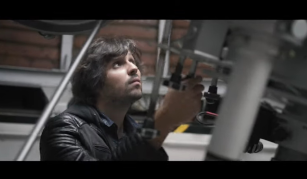 Watch the spot announcing our new series of short promo movies Creating a Better Tomorrow - on research carried out by scientists from the Faculty of Physics, Astronomy and Applied Computer Science at the Jagiellonian University in Kraków. They will be published every Monday starting on November 9, 2020.
Watch the spot announcing our new series of short promo movies Creating a Better Tomorrow - on research carried out by scientists from the Faculty of Physics, Astronomy and Applied Computer Science at the Jagiellonian University in Kraków. They will be published every Monday starting on November 9, 2020.
Professor Marek Szydłowski has died

With deep regret we inform about the death of our long-term employee, prof. dr hab. Marek Szydłowski. Last farewell to prof. Szydłowski will be held on Saturday, 10 October at 12:00, in the cemetery chapel in Wierzchosławice near Tarmów.
Astronomy Object of the Month: GRBs as Standard Candles: observations vs. theory
A study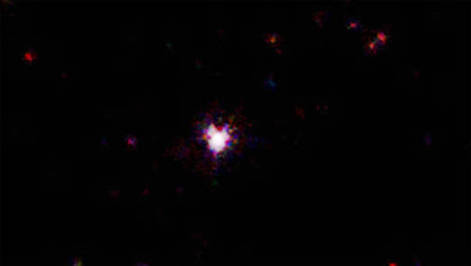 study presenting the most comprehensive analysis of Gamma-Ray Bursts (GRBs) detected by the Neils Gehrels Swift Observatory to this day has been presented in a new article accepted in the Astrophysical Journal Supplements Series. The analysis was performed by an international team led by Dr. Maria Giovanna Dainotti, assistant Professor at Jagiellonian University concurrently serving as affiliated Scientist at Space Science Institute in Colorado, and as a mentor of the Science Undergraduate Laboratory Internships (SULI) program at Stanford University.
study presenting the most comprehensive analysis of Gamma-Ray Bursts (GRBs) detected by the Neils Gehrels Swift Observatory to this day has been presented in a new article accepted in the Astrophysical Journal Supplements Series. The analysis was performed by an international team led by Dr. Maria Giovanna Dainotti, assistant Professor at Jagiellonian University concurrently serving as affiliated Scientist at Space Science Institute in Colorado, and as a mentor of the Science Undergraduate Laboratory Internships (SULI) program at Stanford University.
Nobel Prize in Physics 2020: Black Holes and the Mysterious Center of the Milky Way
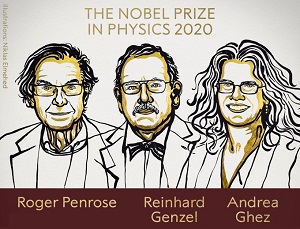 This year's Nobel Prize in Physics was awarded to Roger Penrose, for confirming the consistency of the theory of relativity with the formation of black holes, and to Reinhard Genzl and Andrea Ghez for the discovery of a supermassive compact object in the center of our Galaxy.
This year's Nobel Prize in Physics was awarded to Roger Penrose, for confirming the consistency of the theory of relativity with the formation of black holes, and to Reinhard Genzl and Andrea Ghez for the discovery of a supermassive compact object in the center of our Galaxy.
Astronomy Object of the Month: The most widespread, regular magnetic field in the Universe
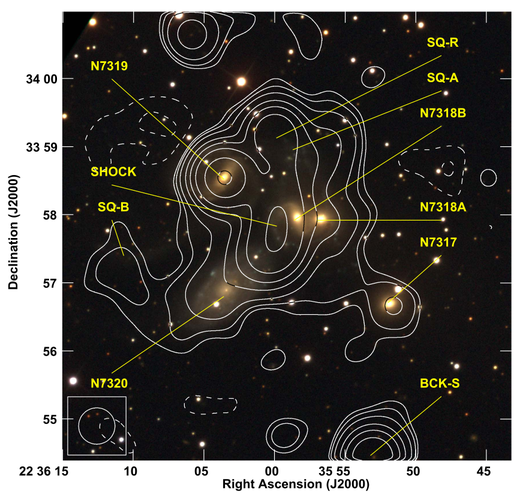 A team of scientists from the Jagiellonian University and CSIRO has published an article that describes a vast, magnetised structure found in a small, compact galaxy group – the Stephan’s Quintet. It seems that we are facing some kind of a magnetic „screen”, with an extent of at least 200 000 on 130 000 on 65 000 light years. It is the largest known, regularly magnetised structure in the Universe.
A team of scientists from the Jagiellonian University and CSIRO has published an article that describes a vast, magnetised structure found in a small, compact galaxy group – the Stephan’s Quintet. It seems that we are facing some kind of a magnetic „screen”, with an extent of at least 200 000 on 130 000 on 65 000 light years. It is the largest known, regularly magnetised structure in the Universe.
Astronomer won the 1st edition of the Frank Wilczek Prize
 In accordance with the decision of the Prize Committee, Dr. Przemysław Mróz has been chosen as the Laureate of the Frank Wilczek Prize for his outstanding research achievement entitled Free-floating planets - a new category of exoplanets.
In accordance with the decision of the Prize Committee, Dr. Przemysław Mróz has been chosen as the Laureate of the Frank Wilczek Prize for his outstanding research achievement entitled Free-floating planets - a new category of exoplanets.
Astronomy Object of the Month: Non-interacting coronal mass ejections and solar energetic particles near the quadrature configuration of Solar TErrestrial RElations Observatory
Space weather is mainly controlled by the strong magnetic storms and particle storms which are caused by the enhanced fluxes of protons and ions. These accelerated plasmas are known as solar energetic particles (SEPs). The generation of SEP is mainly due to two phenomenon, impulsive SEP events caused by magnetic reconnection manifested as solar flares, and gradual SEP events accelerated by strong shocks associated with coronal mass ejections (CMEs). In this paper we have shown that our method of employing so-called instantaneous speed (maximum speed and the CME speed and Mach number at SEP peak flux) offers better correlation than the average speed. In addition, we observe poor correlation between fluxes of SEPs and Flares, which support the hypothesis that energetic particles observed in the considered energy range are predominantly accelerated by CME shock.
Professor Adam Strzałkowski has died
 We are sorry to inform that prof. dr hab. Adam Strzałkowski died on July 25, 2020.
We are sorry to inform that prof. dr hab. Adam Strzałkowski died on July 25, 2020.
Katarzyna Otmianowska-Mazur (1957-2020)
 We regret to inform you that prof. dr hab. Katarzyna Otmianowska-Mazur, a longtime employee and director of the Astronomical Observatory of the Jagiellonian University, died on July 14, 2020.
We regret to inform you that prof. dr hab. Katarzyna Otmianowska-Mazur, a longtime employee and director of the Astronomical Observatory of the Jagiellonian University, died on July 14, 2020.
Astronomy Object of the Month: The discovery of high-energy gamma rays from the jet of the active galaxy Centaurus A
.jpg) On June 17, journal Nature published the paper of researchers from the international H.E.S.S. Observatory, presenting the discovery of high-energy gamma emission from the relativistic beam, or "jet", of the nearby active galaxy Centaurus A (Cen A). This important astronomical discovery was made with participation of Polish scientists, including the team from the Astronomical Observatory of the Jagiellonian University.
On June 17, journal Nature published the paper of researchers from the international H.E.S.S. Observatory, presenting the discovery of high-energy gamma emission from the relativistic beam, or "jet", of the nearby active galaxy Centaurus A (Cen A). This important astronomical discovery was made with participation of Polish scientists, including the team from the Astronomical Observatory of the Jagiellonian University.
Astronomy Object of the Month: Pulsating blue subdwarfs and planets which are not there
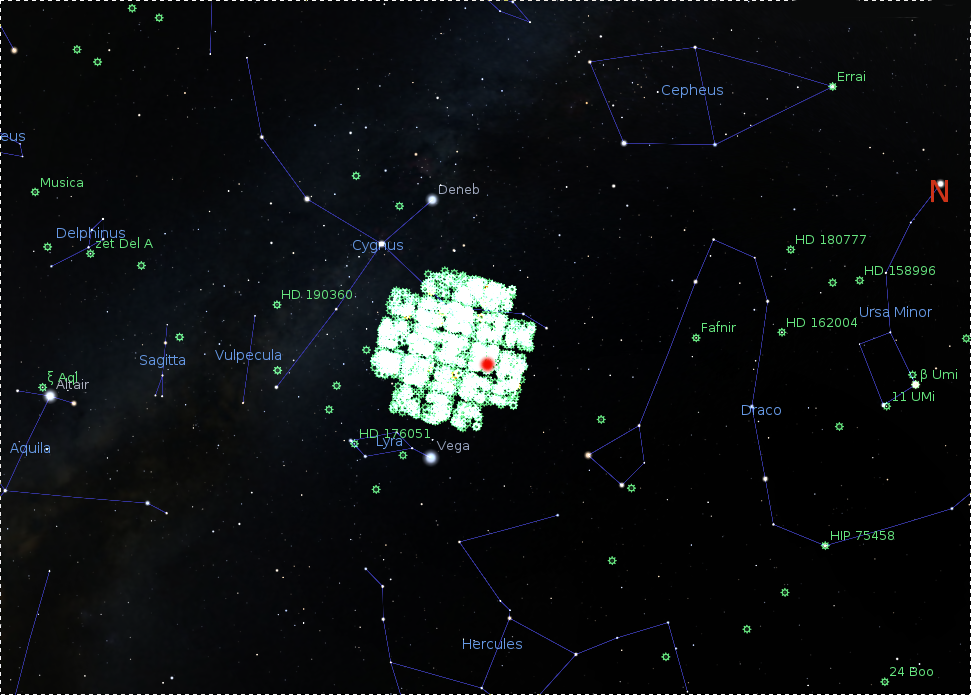 In 2011 and 2014, reports appeared that two pulsating sdBV stars observed by the Kepler Space Telescope, KIC 5807616 and KIC 10001893, could be circled by extrasolar planets on tight orbits. However, a new analysis of the putative planetary signatures found in the light curves of these stars shows that there are no planets around them. The research involved professor Jerzy Krzesiński from the Astronomical Observatory of the Jagiellonian University in Kraków and his PhD student Adam Blokesz from the Pedagogical University of Kraków.
In 2011 and 2014, reports appeared that two pulsating sdBV stars observed by the Kepler Space Telescope, KIC 5807616 and KIC 10001893, could be circled by extrasolar planets on tight orbits. However, a new analysis of the putative planetary signatures found in the light curves of these stars shows that there are no planets around them. The research involved professor Jerzy Krzesiński from the Astronomical Observatory of the Jagiellonian University in Kraków and his PhD student Adam Blokesz from the Pedagogical University of Kraków.
Astronomy Object of the Month: Spitzer Telescope test Einstein Gravity: repeated explosions near a black hole give a clue
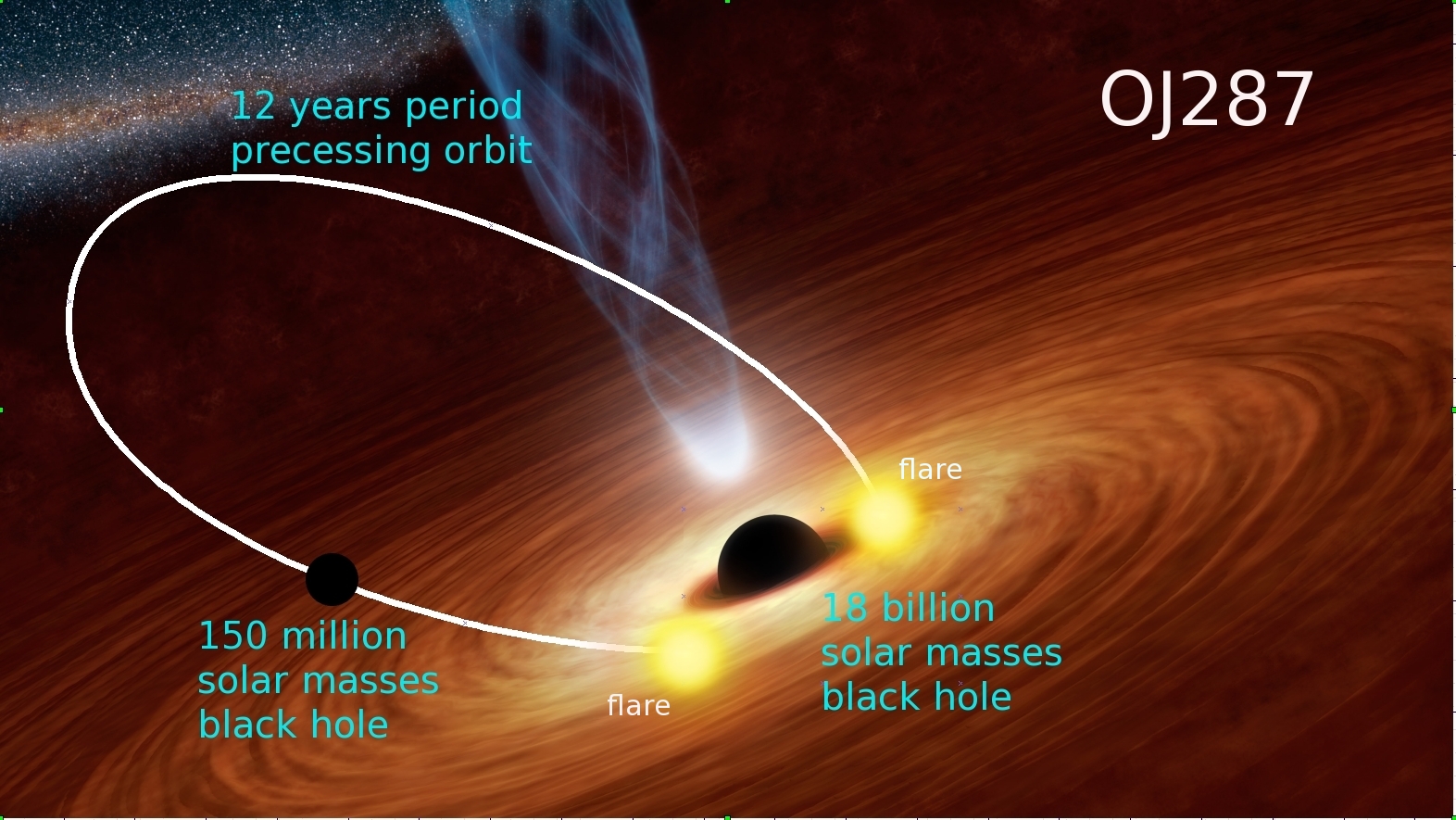 A very recent observation of a predicted flaring from a distant galaxy by Spitzer Space Telescope has firmly established the existence of a massive black hole pair emitting nano-Hertz gravitational waves which should assist the on-going international efforts to directly detect such waves. Spitzer observation is also constraining a unique property of black holes, explored by Stephen Hawking and collaborators.
A very recent observation of a predicted flaring from a distant galaxy by Spitzer Space Telescope has firmly established the existence of a massive black hole pair emitting nano-Hertz gravitational waves which should assist the on-going international efforts to directly detect such waves. Spitzer observation is also constraining a unique property of black holes, explored by Stephen Hawking and collaborators.
Astronomy Object of the Month: Examination of microvariability of the flux and the polarization of blazars in the optical band
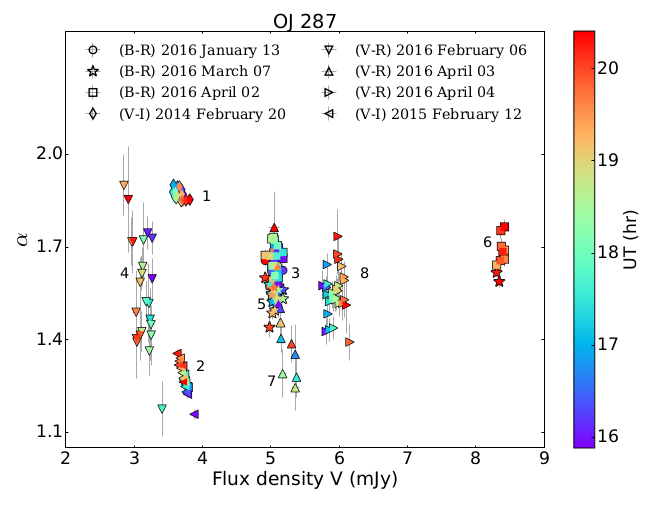 Active Galactic Nuclei (AGNs) consists of galaxies with extremely bright nucleus, so much so, that they usually outshine the light from other galaxy parts such as arms or bulges. The reason behind intense power of AGN is believed to be that at the centre of galaxy a super massive black hole (SMBH) is accreting matter from its vicinity. Sometimes, such systems are known to erupt powerful, narrow beam of high velocity charged particles. If one happens to view such a systems along the line of sight of these eruptions (jets) are called blazars. The emission from blazar jets is Doppler boosted, leading to extreme luminosities and flux variability and apparent superluminal motion shown by the ejecta.
Active Galactic Nuclei (AGNs) consists of galaxies with extremely bright nucleus, so much so, that they usually outshine the light from other galaxy parts such as arms or bulges. The reason behind intense power of AGN is believed to be that at the centre of galaxy a super massive black hole (SMBH) is accreting matter from its vicinity. Sometimes, such systems are known to erupt powerful, narrow beam of high velocity charged particles. If one happens to view such a systems along the line of sight of these eruptions (jets) are called blazars. The emission from blazar jets is Doppler boosted, leading to extreme luminosities and flux variability and apparent superluminal motion shown by the ejecta.
Astronomy Object of the Month: The Nature of γ-ray Variability in Blazars
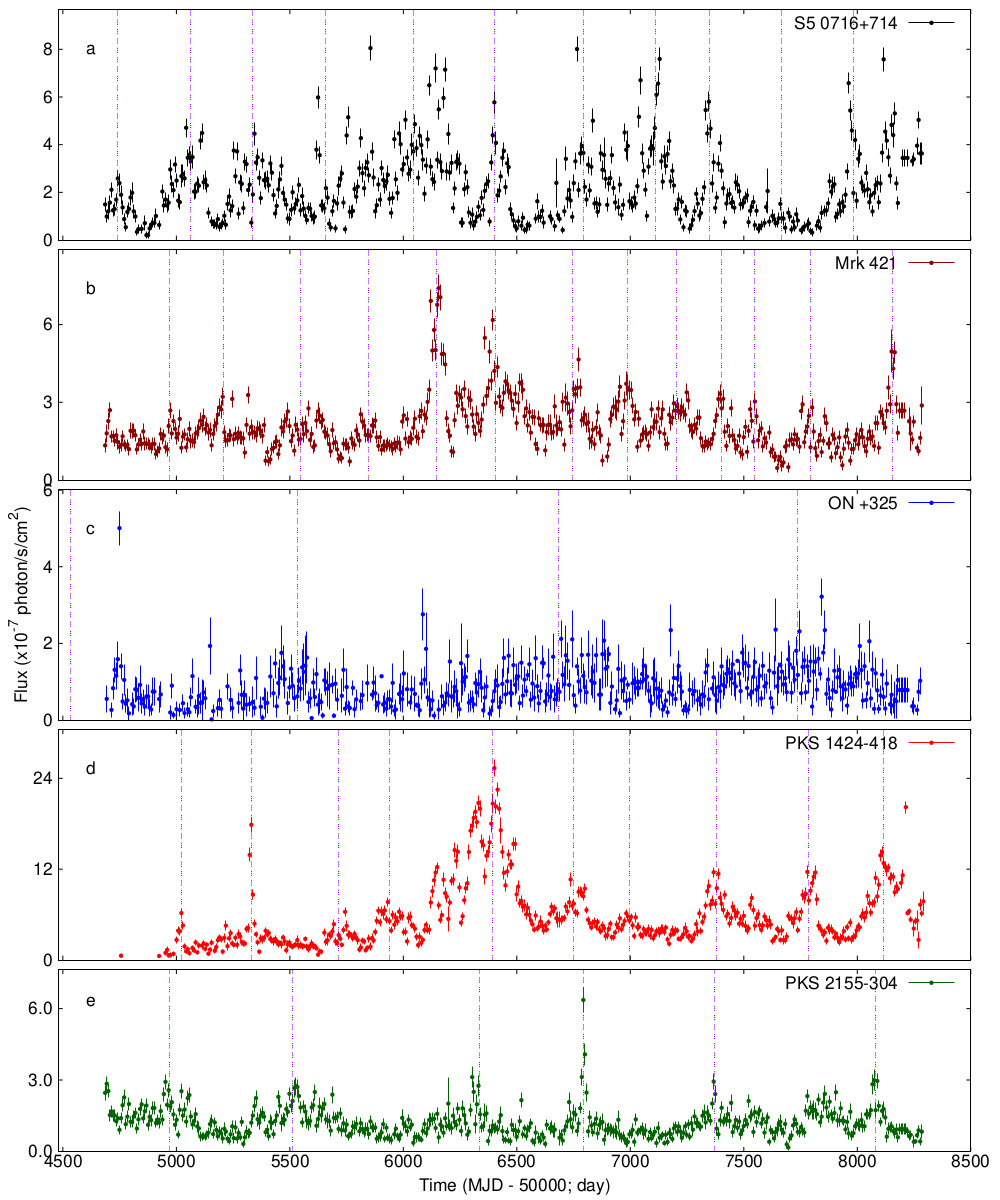 Blazars shine predominatly in high energy emission, e. g. X-ray and gamma-ray wave bands. It is widely believed that the high energy emission is produced via synchrotron and inverse-Compton processes at the relativistic shock waves which propagate along the blazar jets or magnetic reconnection processes in case of highly magnetized jets. However, in spite of the collaborative efforts of several modern space and earth bound telescopes, the details of the mechanisms and the exact location of the production of the high energy emission, in reference to the central engine, remain elusive.
Blazars shine predominatly in high energy emission, e. g. X-ray and gamma-ray wave bands. It is widely believed that the high energy emission is produced via synchrotron and inverse-Compton processes at the relativistic shock waves which propagate along the blazar jets or magnetic reconnection processes in case of highly magnetized jets. However, in spite of the collaborative efforts of several modern space and earth bound telescopes, the details of the mechanisms and the exact location of the production of the high energy emission, in reference to the central engine, remain elusive.
Astronomy Object of the Month: CSO radio sources and efficiency of their jets
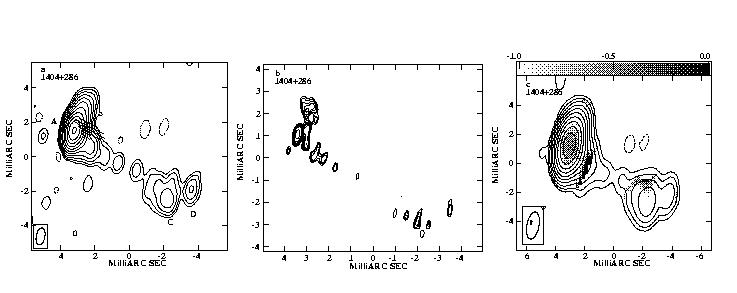 The international team headed by astronomers from the Jagiellonian University has published detailed research on the jet production efficiency in a sample of 17 selected young radio galaxies, for which the observed luminosities of their jets, radio lobes and accretion disks seem to correspond to the same episode of the central activity of their parent galaxies.
The international team headed by astronomers from the Jagiellonian University has published detailed research on the jet production efficiency in a sample of 17 selected young radio galaxies, for which the observed luminosities of their jets, radio lobes and accretion disks seem to correspond to the same episode of the central activity of their parent galaxies.
Astronomy Object of the Month: The catalogue of giant radio sources
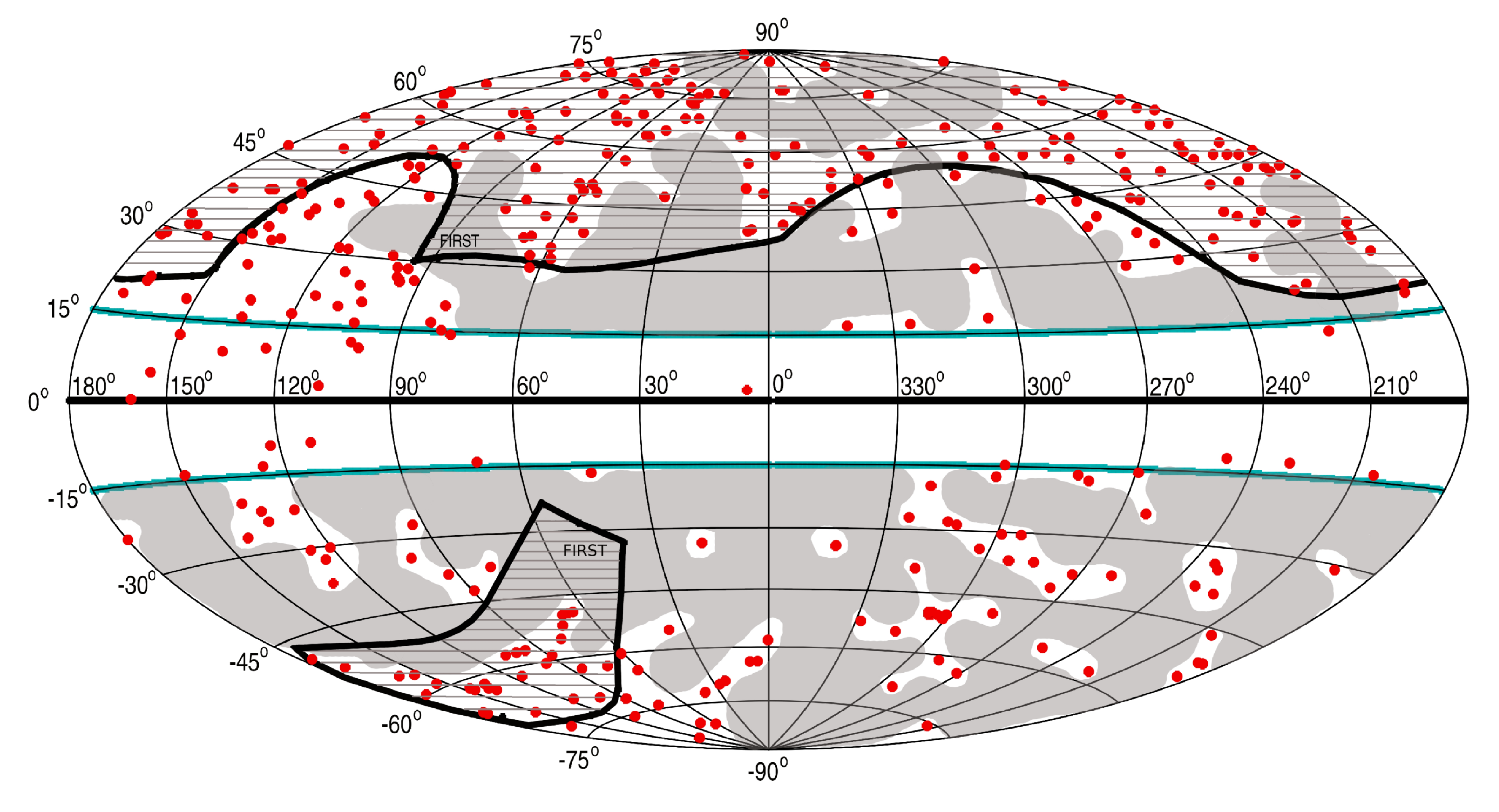 Giant radio sources are a peculiar class of objects due to the extremely large (> 0.7 Mpc) sizes of their observed radio structures. It is believed that this is relatively rare feature, because only ~5% of all known radio sources exceed this size. The reasons why some radio sources have grown to such large sizes are not fully explained, however detailed multiwavelength studies have progressed significantly our knowledge about the nature of giants.
Giant radio sources are a peculiar class of objects due to the extremely large (> 0.7 Mpc) sizes of their observed radio structures. It is believed that this is relatively rare feature, because only ~5% of all known radio sources exceed this size. The reasons why some radio sources have grown to such large sizes are not fully explained, however detailed multiwavelength studies have progressed significantly our knowledge about the nature of giants.



